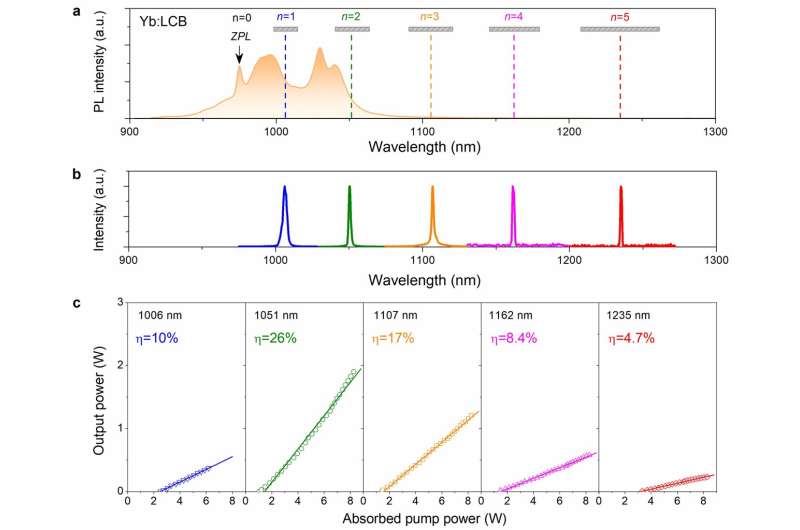This article has been reviewed according to Science X's editorial process and policies. Editors have highlighted the following attributes while ensuring the content's credibility:
fact-checked
peer-reviewed publication
trusted source
proofread
Phonon engineering for extended lasing beyond the fluorescence spectrum

The electron and phonon are two fundamental particles (quasi-particles) of condensed matter and their interplay in single crystals can create many interesting physical phenomena, such as polaritons, charge density waves and up-conversion fluorescence. In laser crystal, the electronic transitions of an active ion can be manipulated by its surrounding lattice vibrations, whereby the emitting photon energy gradually decreases or increases by the creation or annihilation of quantized phonons.
Therefore, some broadband laser wavelengths can be designed by the selective amplification of phonon-assisted emission, including Ti:Sapphire, alexandrite, Cr:LiSAF, and so on. However, all these laser wavelengths still locate inside the spontaneous fluorescence spectrum, or slightly outside with a few nanometers.
In multiphonon-assisted emission, the creation of high-order phonons can reduce photon energy step by step, thus pushing laser wavelengths far beyond the spontaneous fluorescence spectrum. Recently, Liang et. al. demonstrated such a multiphonon-assisted lasing in Yb:YCa4O(BO3)3 (Yb:YCOB) crystal with phonon number n = 3~8, which attributed to constructive interactions of vibrational modes from "free-oxygen" sites.
However, borates containing "free-oxygen" are very rare, less than one percent of the total rare-earth borates, thereby giving a limitation for searching more strong-coupling laser materials. Therefore, searching new structural motif in rare-earth borates is very essential to elaborate the physics mechanism of multiphonon coupling lasing, and also find their distinctive applications in our life.
Yb-doped La2CaB10O19 (Yb:LCB) crystal is a multi-functional laser crystal invented by Prof. Yicheng Wu in 1998. Here, the authors present a broadband laser emission in Yb:LCB crystal beyond its fluorescence spectrum. The electron-phonon coupling intensity is calculated by Huang-Rhys S factor and the phonon-assisted fluorescence lineshape is predicted numerically.
A broadband lasing emission spectrum (1000-1280 nm) is obtained by amplifying the weak multiphonon-assisted transitions step-by-step with increasing phonon numbers n=1 ~ 6. Theoretical calculations show that such a substantial lasing spectrum is devoted to multiphonon coupling at a dangling "quasi-free-oxygen" site, as demonstrated by the in-situ Raman experiment.
The potential of Cheng and colleagues' work does not end there. "Yb:LCB is a non-centrosymmetric crystal, it is possible to make a multidisciplinary coupling between multiphonon-coupled lasing and frequency-doubling, thus making a self-frequency doubling laser with the extended wavelengths in the visible range or self-OPO laser in mid-infrared range." they added.
"This multiphonon coupling laser represents a significant step forward for broadband tunable sources and provides a versatile route for many applications, e.g. ultrafast laser, frequency-comb, laser display and dermatology. This would be a milestone work in solid-state laser engineering, as the invention of ruby and Ti:sapphire," the scientists say.
The study is published in the journal Light: Science & Applications.
More information: Yanling Cheng et al, Phonon engineering in Yb:La2CaB10O19 crystal for extended lasing beyond the fluorescence spectrum, Light: Science & Applications (2023). DOI: 10.1038/s41377-023-01243-x
Journal information: Light: Science & Applications
Provided by Chinese Academy of Sciences




















